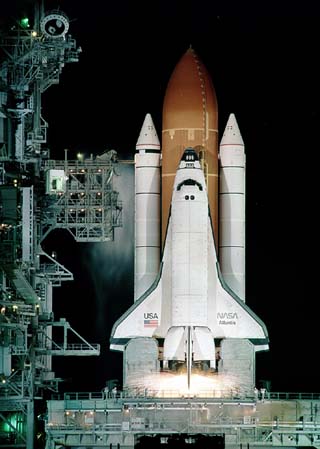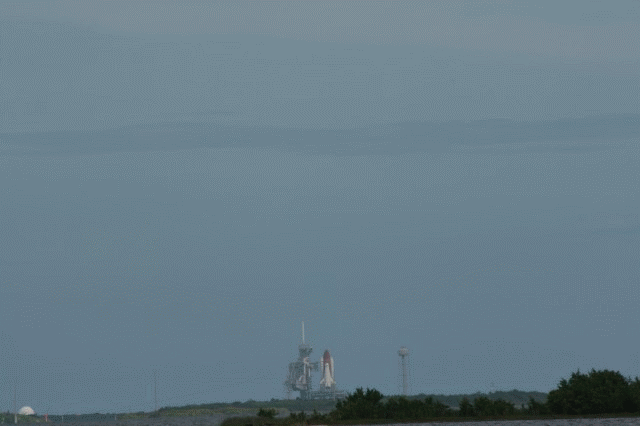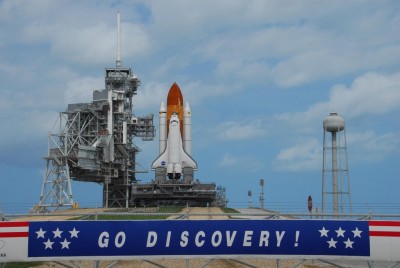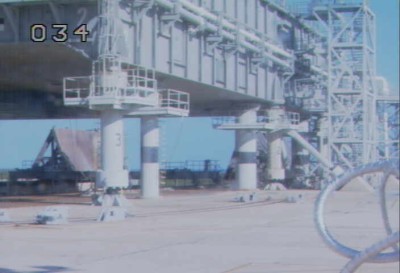 I thought its time to write a bit about the space shuttle itself. As many say, it is the world’s most complex machine ever built.
I thought its time to write a bit about the space shuttle itself. As many say, it is the world’s most complex machine ever built.
The space shuttle made its maiden flight on April, 12th 1981 and will, based on current plans, be retired in 2010 after completing the construction of the international space station, its current primary target.
The space shuttle was developed as a replacement for the Apollo spacecrafts. Contrary to Apollo, it can reach low earth orbit, only. It is not capable to go to the moon.
The space shuttle’s major components are the boosters, external tank and the orbiter. The orbiter is the airplane-shaped white “ship” that is commonly called “the shuttle”, though it is only part of it. The reddish external tank contains ascent fuel. And the white booster rockets on the sides of the external tank provide the main propulsion for the initial flight phase after launch.
Its main feature was reusability of most parts. Only the external tank is lost on launch, the boosters glide back to earth on parachutes after separation from the craft. The initial design called for huge savings from that fact – something the space shuttle could not life up to. Some sources quote that NASA expected to have as much as one flight per week and the shuttle to replace all other launch vehicles. In practice, only a few launches per year were achievable and each of them being much more expensive than initially thought.
The space shuttle program was compromised by budget cuts in its early design phase. Initially, it was planned to have the actual orbiter sitting on top of the external tank and boosters. There would obviously be a different design for the main engines in this concept, too. The then-chosen configuration with the orbiter being mounted to the side of these components is a trouble source until today. It exposes the shuttle to launch debris, for example parts of the external tanks foam isolation that fall off during launch.
Launch debris is very hard to avoid. On launch, each spacecraft is shaken quite well. So chances are great something will go off. With all designs but the space shuttle, this poses no problem, because no vital system can be hit by such debris. If you look at Apollo-days Saturn V launches, you will see lots of ice falling off, but the crew capsule and their support system sat well protected above the debris source. Consequently, NASA’s new constellation moon program designs an Apollo-like craft with the vital systems again sitting on top of the launch propulsion system.
In my personal opinion, the space shuttle is a good example why budget constrains should not overrule engineering decisions. NASA paid badly for the initial savings…
Besides that problem, the space shuttle is an incredible and fascinating machine. Among its many great achievements is the delivery and continued servicing of the Hubble Space Telescope. Also, construction of the international space station ISS depends on space shuttles doing the heavy hauling. The space shuttle is also the only spacecraft ever capable to capture massive satellites in orbit and deliver them back to earth.
The space shuttle is also very inspiring. Viewing a space shuttle launch is a special experience.
Astronauts also praise the space shuttle for its roominess and the smooth ascent and descent, which puts very low G-forces on the crew.
NASA’s future constellation space program borrows heavily both at the space shuttle and Apollo programs. It is expected to get the best of two worlds. For example, Ares rockets will fly modified space shuttle boosters.
So while the space shuttle has some weaknesses, it is a very successful craft that not only contributed significantly to science, but will also help pave the way to the Moon, Mars and beyond. In my personal opinion, even the weaknesses were kind of success: they proved which things needed to be done differently. And, of course, a lot of issues were already fixed during the lifetime of the space shuttle program.
Currently, the shuttle fleet is set to retire in 2010. This is a political decision not backed by hard technical fact. In my personal opinion, I would like to see the space shuttle flying at least once a year until the Ares I and Orion vehicles are ready to launch. Of course, I do not know exactly what this requires, but I am a bit hesitant to leave access to the international space station just to the Russians. I also doubt that there will really be a “just” six-year inability of carrying humans into space – the Constellation program already has some of its schedule’s slipping. And with an endeavor as complex Constellation, it would be wise to count on some more schedule slips. I wouldn’t be surprised if the first Ares manned flight will not happen before 2018…
The space shuttle has received numerous fixes both in procedures and technology. It is more capable than ever before. It is safer than ever before. Wouldn’t it be wise to count on it as long as its successor is not ready?





